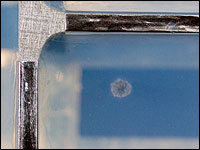Space Probe Yields First Comet Samples

View Gallery
Millions of cometary particles may be trapped inside Stardust's gel-filled collector tray. Seen here, a cometary particle impact site. NASA
Donald Brownlee, Stardust principal investigator with the University of Washington, flashes a victory sign for the successful arrival of Stardust material. Also pictured, left to right, Mike Zolensky, Friedrich Horz,and Peter Tsou. NASA
All Things Considered, January 19, 2006 ·
Scientists scrutinizing comet and stellar particles from the Stardust spacecraft are ecstatic about what they're seeing. The space capsule drifted to Earth Sunday, making a safe landing in Utah after a seven-year, 3-billion-mile journey to Comet Wild 2.
Its cargo of cosmic particles is now at the Johnson Space Center in Houston, where scientists cracked open the capsule Tuesday. The researchers are the first humans ever to come face to face with comet particles.
"At this point in time, we're absolutely thrilled," said Donald Brownlee, a University of Washington scientist and principal investigator. "It's totally remarkable to have a fully successful mission. Of all the things that could go wrong either in space or even scientifically, none of the bad things happened and everything really exceeded our wildest expectations."
Stardust's collector tray captured perhaps a million particles of comet dust on one side and maybe 200 grains of star dust on the other. There were fears the particles would explode on impact, but the dense gel that gathered them appears to have cushioned the collisions.
Study of these particles could yield new information about how the solar system and Earth formed -- and the origins of life on Earth.
"It's like looking at our great, great grandparents," says Mike Zolensky, a JSC Stardust researcher. "Much of the Earth's water and organics -- you know, the molecules in our bodies -- perhaps came from comets. So these samples will tell us ... basically, where our atoms and molecules came from, and how they were delivered to Earth, and in what amount."
With Stardust's delivery, scientists now have solid material to refer to as they contemplate the origins of life.
"For all the ideas and theories that people might have, we have some sort of real ground truth," explains Brownlee. "We have actual samples of materials the solar system was formed from."
Some 160 scientists around the world will participate in the Stardust research. And 65,000 people have signed up to help locate the smallest particles of star dust with their home computers. NASA will provide software and images of portions of the collector cells and the volunteers will scan them for particles. The Stardust scientists hope to announce their first scientific findings in a little more than a month. They believe they have enough star and comet dust to keep researchers busy for decades.













